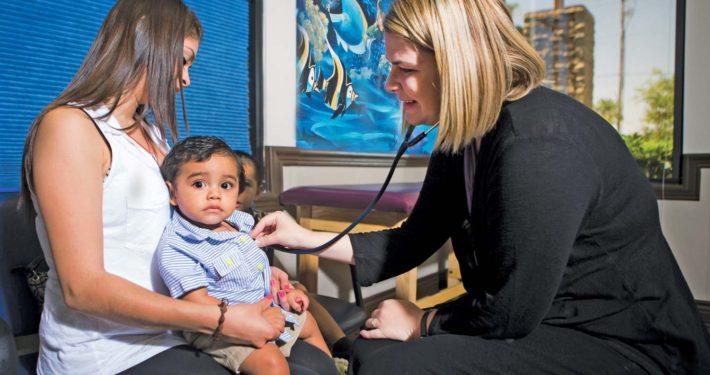At Your Fingertips: A Chance to Advance Pediatric Research With Your Practice’s Electronic Health Record Data
Dr. R. “Mort” Wasserman describes the benefits of participating in ePROS.
What if researchers could use their electronic health record (EHR) data? Have you heard of Pediatric Research in Office Settings (PROS), the practice-based research network of the American Academy of Pediatrics (AAP)?
PROS was founded in the 1980s as a collaboration with independent pediatric practitioners and the AAP and pediatric researchers. Now in its 30th year, PROS has allowed independent pediatricians to help generate new knowledge while engaged in the day-to-day work of pediatric practice. Findings from PROS research have made and continue to make a major impact in pediatrics. For example, in the adolescent medicine world, a PROS study provided the first evidence that girls were maturing earlier than stated in textbooks1 and led to the revision of guidelines for referral for precocious puberty.2 The guidelines to be released in the coming year on the management of febrile infants will be significantly informed by data from a major PROS study,3 and the results of a recently published PROS randomized controlled trial4 have shown that motivational interviewing done in pediatric practice can help ameliorate pediatric obesity.
The mission of ePROS, very similar to PROS, is to improve the health of children and enhance primary care practice by conducting and fostering national collaborative practice-based research using electronic health record systems.
In ePROS, after a data use agreement between the AAP and a participating practice has been signed, a HIPAA-limited dataset, deidentified in such a way as to be usable for research without need of written consent,5 is extracted from the practice’s EHR. The original ePROS model required involvement of a data extraction vendor to pull and standardize the EHR data, but PROS has now changed its model for ePROS. One variation has been implemented for a practice that had the ability to extract and deidentify its own EHR data and has made it available for analysis. Allied Physicians Group (formerly Allied Pediatrics of New York) has joined ePROS under this arrangement. Most independent practices do not, however, have the informatics capacity to extract, standardize, and deidentify their EHR data. So ePROS is moving to what is likely to be a more widely available model involving interested EHR vendors.
Two EHR vendors, Physician’s Computer Company (PCC) and Office Practicum (OP), recently have agreed in principle to work with the AAP to help recruit ePROS practices from among their clients and, after interested practices have signed data use agreements with the AAP, periodically extract HIPAA-limited datasets from these practices for use in research. This is an exciting development for ePROS in that it will make available EHR data from a large group of independent practices whose patients might otherwise be missing from important research, and which can be added to an even larger AAP EHR data collaboration6
in order to get the most accurate picture of U.S. pediatric health care.
How would ePROS practices benefit?
Practices benefit from ePROS participation by:
- Learning how their patients compare with the patients of other practices (e.g., prevalence of common conditions such as obesity and attention deficit hyperactivity disorder)
- Learning how the care their practice delivers (e.g., medications prescribed) compares with the care delivered by other practices
- Receiving recognition from the AAP for participation in ePROS
- Knowing that their practice is contributing to a national effort to improve pediatric care for all children by generating new knowledge.
In addition, potential ePROS benefits of the future could include Maintenance of Certification Part IV credit for projects designed to be implemented through ePROS and satisfaction of the Meaningful Use Stage 3 requirement for public health and clinical data registry reporting.
Although the benefits of ePROS participation will initially be limited to practices that use the OP or PCC EHR systems, the AAP is certainly open to working with other EHR vendors interested in ePROS.
For additional information about ePROS, contact R. “Mort” Wasserman (rwasserm@uvm.edu) or Alex Fiks.
[1] Herman-Giddens ME, Slora EJ, Wasserman RC, Bourdony CJ, Bhapkar MV, Koch GG, Hasemeier CM. Secondary sexual characteristics and menses in young girls seen in office practice: a study from the pediatric research in office settings (PROS) network. Pediatrics 1997; 99:505-512. ↑
[2] Kaplowitz PB, Oberfield S, Drug and Therapeutics and Executive Committees of the Lawson Wilkins Pediatric Endocrine Society. Reexamination of the age limit for defining when puberty is precocious in girls in the United States: implications for evaluation and treatment. Pediatrics 1999; 104:936-941. ↑
[3] Pantell RH, Newman TB, Bernzweig J, Bergman DA, Takayama JI, Segal M, Finch SA, Wasserman RC. Management and outcomes of care of fever in early infancy. JAMA 2004; 291:1203-1212. ↑
[4] Resnicow K, McMaster F, Bocian A, Harris D, Zhou Y, Snetselaar L, Schwartz R, Myers E, Gotlieb J, Foster J, Hollinger D, Smith K, Woolford S, Mueller D, Wasserman R. Motivational interviewing and dietary counseling for obesity in primary care: an RCT. Pediatrics 2015; 135:649-657. ↑
[5] National Institutes of Health. “How can covered entities use and disclose protected health information for research and comply with the privacy rule?” Accessed July 3, 2015. http://privacyruleandresearch.nih.gov/pr_08.asp ↑
[6] Fiks AG, Grundmeier RW, Steffes J, Adams W, Kaelber D, Pace W, Wasserman RC, for the Comparative Effectiveness Research through Collaborative Electronic Reporting (CER2) Consortium. Comparative effectiveness research through a collaborative electronic reporting consortium. Pediatrics. Published online doi: 10.1542/peds.2015-0673 ↑
Vermont’s Dr. Richard “Mort” Wasserman, director of the AAP’s Pediatric Research in Office Settings (PROS) Network, explains how practices can use their own electronic health record data to conduct clinical and observational research aimed at improving care.










